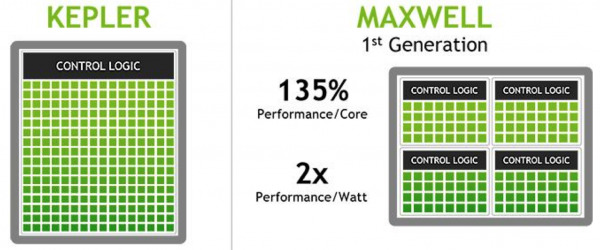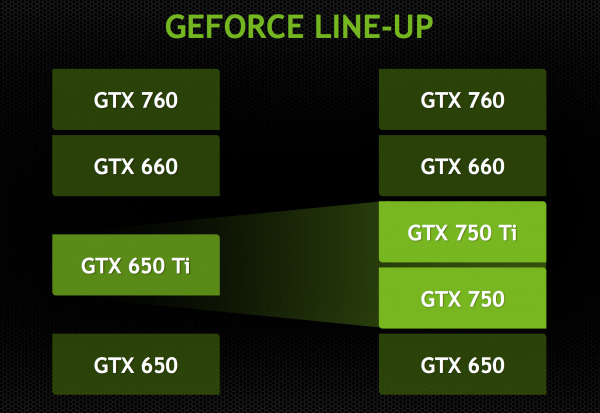NVIDIA GeForce GTX 750 Ti Review
With the NVIDIA GeForce GTX 750 and 750 Ti comes the company's first implementation of their 1st generation Maxwell GPU architecture. Maxwell brings what NVIDIA suggests is the most efficient GPU on the market – efficiency, that is, doing more with less. NVIDIA says they've increased the performance of Maxwell up per watt up 2x over Kepler.
Both Maxwell and Kepler work with the same 28-nm process. Kepler works with 192 cores across a single piece of SM contained control logic while Maxwell rolls with four blocks of SM control logic with 32 cores each. Each of Maxwell's blocks are controlled by their own bit of SM.

This card is made to replace the GTX 650 Ti in two iterations – 750 and 750 Ti, and NVIDIA suggests it out-performs the GTX 550 Ti by 2x. Power performance between GTX 550 Ti (with Fermi) and GTX 750 Ti is 4x – this graphics card requires so little power it needs no power connector. NVIDIA GeForce GTX 750 Ti requires only 60W TDP*.
*TDP (Thermal Design Point) is the max power this computer's cooling system is required to dissipate. This is in "normal" circumstances, running applications – more power can be drawn in extreme circumstances, such as with a power virus (bad).

Make no mistake, though, if you're rolling with a highest-end GPU from the past few years, you're not going to be upgrading to the GTX 750 Ti. This card, instead, is one you're going to choose if you're going to make a new mini-PC, machines with 300W PSUs, or upgrading from a GTX 550.
Graphics Processing Clusters: 1
Streaming Multiprocessors: 5
CUDA Cores: 640
Texture Units: 40
ROP Units: 16
Base Clock: 1020 MHz
Boost Clock: 1085 MHz
Memory Clock (Data rate): 5400 MHz
L2 Cache Size: 2048KB
Total Video Memory: 2048MB GDDR5
Memory Interface: 128-bit
Total Memory Bandwidth: 86.4 GB/s
Texture Filtering Rate (Bilinear): 40.8 GigaTexels/sec
Fabrication Process: 28 nm
Transistor Count: 1.87 Billion
Connectors: 2 x Dual-Link DVI 1 x mini-HDMI
Form Factor: 2 Slots
Power Connectors: None
Recommended Power Supply: 300 Watts
Thermal Design Power (TDP): 60 Watts
Thermal Threshold: 95° C
This card brings on a variety of current-generation NVIDIA-specific abilities, of course, like ShadowPlay – built-in to NVIDIA GeForce Experience for game screen recording and streaming. ShadowPlay works particularly well here thanks to NVIDIA's implementation of an improved NVENC encoder.

Also in play here is NVIDIA SHIELD streaming abilities. Just like we saw when we first published our NVIDIA SHIELD Review, this GPU allows you to stream games on your own wireless network to SHIELD or to SHIELD and back out through HDMI to your big-screen TV.
Benchmarks
We performed a few benchmark tests with a build that's organized as follows: 3rd Generation Intel Core i7 processor (overclocked to 4.5GHz), ASUS P8Z77-I Deluxe mini ITX motherboard, with 8GB DDR3 SDRAM 934MHz. We've got the NVIDIA 334.69 64bit driver installed as well, if you'd like to know.
First with Hitman: Absolution, we tested with Quality Level set on Ultra, Resolution at 2560 x 1440, Refresh Rate at 75, MSAA 8x, VSync off, FXAA on, Global Illumination on, Tesselation on. Results we've kicked out on include Minimum FPS: 3.555556, Maximum FPS: 14, and Average FPS: 10.284755.
With Metro: Last Light, we've pushed out a Resolution of 2560 x 1440 with Direct X, DirectX 11, Quality "Very High", Texture filtering AF 16x, Advanced PhysX enabled, Tesselation "Very High", Motion blur "Normal", and SSAA OFF. Results in three runs are as follows:
• Total Frames: 2807, Total Time: 171.1078 sec
• Average Framerate: 16.44
• Max Framerate: 44.31 (Frame: 2382)
• Minimum Framerate: 11.59 (Frame: 552)
• Total Frames: 2809, Total Time: 171.1558 sec
• Average Framerate: 16.45
• Max Framerate: 44.32 (Frame: 9)
• Minimum Framerate: 11.52 (Frame: 556)
• Total Frames: 2791, Total Time: 171.1793
• Average Framerate: 16.34
• Max Framerate: 49.85 (Frame: 9)
• Minimum Framerate: 11.46 (Frame: 444)
Averages of the three:
Average Framerate: 16.33
Max Framerate: 49.85
Minimum Framerate: 11.46
With the following settings we're getting FAR better results – better since this card isn't aimed at the settings we've kicked out above anyway: Resolution: 1280 x 1024; DirectX: DirectX 11; Quality: Low; Texture filtering: AF 4X; Advanced PhysX: Enabled; Tesselation: Normal; Motion Blur: Low; SSAA: ON. Average results: Average Framerate: 30, Max Framerate: 96.56, Minimum Framerate: 17.50.
With 3DMark we've gotten a Fire Strike 1.1 score of 3673 with graphics 3889, physics 10855, and combined score of 1525. Cloud Gate 1.1 we've gotten 16674 with graphics 25695 and physics 7482. In Ice Storm 1.2 we've gotten a score of 94887 with graphics 116955 and physics at 57148.
The test here suggests that our Fire Strike 1.1 score of 3673 is "better than 32% of all results" while a "High End Gaming PC"* result rolls in at 9131 with the same test. This "High End Gaming PC" according to 3DMark is a machine with an Intel Core i7-4770K, ASUSTeK Z87-PRO, and NVIDIA GeForce GTX Titan.
Twitch.TV Streaming Titanfall
We're play-testing Titanfall for a short bit this afternoon from about 4PM until 4:45 or so, Central Time, with the NVIDIA GeForce GTX 750 Ti and Titanfall Beta. Have a peek!
UPDATE: done for now! Stream embedding incoming.UPDATE: For as long as we can host it, here's the Twitch recorded session as it was pushed. Have a peek at how well this machine rolls with NVIDIA ShadowPlay to Twitch here and let us know how you find it:
Watch live video from BurnsyDelight on TwitchTV
Wrap-up
The NVIDIA GeForce 750 Ti is a rather fine bit of equipment if you're looking to create a baseline for gaming in our modern environment. The 750 and 750 Ti also provide a good starting place for Maxwell, a bit of architecture that'll redefine proficiency for graphics cards throughout the GeForce family.
NVIDIA GeForce GTX 750 and 750 Ti cards are being manufactured by ASUS, EVGA, Gainward, Galaxy, Gigabyte, MSI, Palit, and Zotac, with a variety of features depending on the brand. This card is being released for a cool $149 MSRP – we'll see how the rest of the manufacturers configurations stack up soon!
